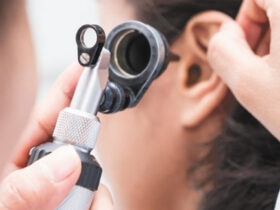Controlling Expectations and Implementing Strategies for Success
By Dr. Noël Crosby, Au.D. –
 There are lots of myths about hearing aids, especially about what they can and cannot do. The truth is that hearing aids cannot restore your hearing to “normal.” However, they can improve communication and understanding.
There are lots of myths about hearing aids, especially about what they can and cannot do. The truth is that hearing aids cannot restore your hearing to “normal.” However, they can improve communication and understanding.
How?
By amplifying sounds so the brain can interpret them. Modern hearing aids can also make amplified hearing “comfortable,” by making soft sounds louder and ensuring loud sounds are not too loud.
The key to achieving success with hearing aids is the responsibility of both the wearer and the speaker. Strategies for success for both parties are outlined below.
Communication Strategies for the LISTENER with Hearing Loss
Step #3: Have Realistic Expectations While Implementing Strategies for Success It takes time to get used to wearing hearing aids. After all, your brain is hearing sounds it hasn’t heard for awhile and it must adjust. Expect that sounds like the clock ticking or the birds chirping or even your own voice will be annoying at first, but remember, everyone with normal hearing is hearing the same thing. You’ve just gotten used to the silence.
If you choose a hearing aid that is worn within the ear canal, you should expect that your ears may get sore at first. Follow your hearing provider’s recommendations about insertion and use the lubricant recommended.
Expect to be frustrated. Learning to use a new technological tool like the hearing aid requires practice and patience. It is no different than the time and patience required to learn how to use a new television or cell phone.
Communication Strategies for the Listener with Hearing Loss
Step #1:
Recognize and understand the signs and symptoms of hearing loss.
Step #2:
Understand treatment options.
Step #3:
Have realistic expectations while implementing strategies for successful adaptation
Step #4:
Make an unwavering commitment to wearing hearing aids or using assistive listening devices.
Step #5:
Develop listening and speech reading skills.
Step #6:
Be assertive. Take responsibility for speech comprehension by taking steps for controlling the listening environment and giving honest and direct feedback to the speaker.
Communication Strategies the Speaker
Step #1:
Stop enabling the hearing impaired listener.
Step #2:
Support and encourage all efforts to get treatment.
Step #3:
Develop strategies for clear speech. (voice intensity, projection, rate and clarity)
Step #4:
Learn to understand and use body language.
Step #5:
Remove physical barriers to speech.
Step #6:
Learn to make the message interesting.
Read aloud daily. If you are new to wearing hearing aids, you will find that you may have to get used to hearing the sound of your own voice. A good way to become accustomed to the sound of your voice again is to read aloud daily for fifteen to twenty minutes.
Keep a journal. Keeping a journal about your adaptation to wearing hearing aids will help your hearing healthcare provider make any necessary adjustments in the programming or fit of your hearing aids. Details you should track and share you’re your provider include:
• How long do you wear hearing aids each day?
• Has communication improved with family members?
• Are voices more distinct?
• How do you hear in social settings? Is background noise too loud or at a comfortable level?
• Can you hear better from a distance?
• Are any sounds too loud?
• Are traffic sounds when riding in the car comfortable?
• Are you using your telecoil and programming buttons (if applicable)?
• Are you cleaning you hearing aids daily?
• Do you have any problems changing the battery?
• Do you have any problems with feedback or whistling?
• What do you like most about your hearing aids?
Communication Strategies for the SPEAKER:
Step #3: Develop Strategies for Clear Speech
Clear speech requires that a speaker consciously attempts to provide the clearest possible sample of the spoken word. Clear speech is most effective when focusing on four key elements:
Clarity: Speaking with clarity means articulating all phonemes, the smallest phonetic unit in a language that is capable of conveying a distinction in meaning, as the m of mat and the b of bat. Voice clarity can be improved by focusing on not rushing while speaking, by swallowing excess saliva and by keeping the jaw loose and the teeth unclenched.
Voice Intensity: Voice intensity refers to volume. Don’t shout when speaking to the hearing impaired. Speaking just a little louder is appropriate.
Projection: Projection goes hand in hand with voice intensity. In normal talking, air is used from the top of the lungs. A projected voiced uses air flowing from the expansion of the diaphragm.
Rate of Speech: Most experts agree that the ideal rate of speech is 180-200 words per minute, a rate appropriate for those with or without hearing loss. To discover your rate of speech, open up your newspaper or favorite book and count off 180 words. Then read the information aloud while timing it. If you read all 180 words in 60 seconds, your rate is 180 words per minute. If you read 160, your rate is 160 words per minute and so forth. Practice adjusting your speech rate to fall within the guidelines.
Next month: Step #4-Making a Commitment to Better Lifelong Hearing and How to Interpret and Use Body Language
PROFESSIONAL BIO
Dr. Noël Crosby, Au.D., owner and practicing audiologist at Advanced Hearing Solutions in Englewood, FL is an experienced professional whose career has been devoted to helping people of all ages hear and understand more clearly.
With over 23 years of experience, Dr. Crosby’s career path is marked by the pursuit of advanced education. After completing her undergraduate requirements, she received her Bachelor and Master of Science degrees from Florida State University and her Doctorate in Audiology from the University of Florida.
Her credibility as an authority grew during her tenure as the Director of Audiology at the Silverstein Institute in Sarasota, FL from 1991-1998. Today, in addition to managing a successful audiology practice, Dr. Crosby just completed her second term as president of The Florida Academy of Audiology.
941-474-8393 | www.drnoelcrosby.com








